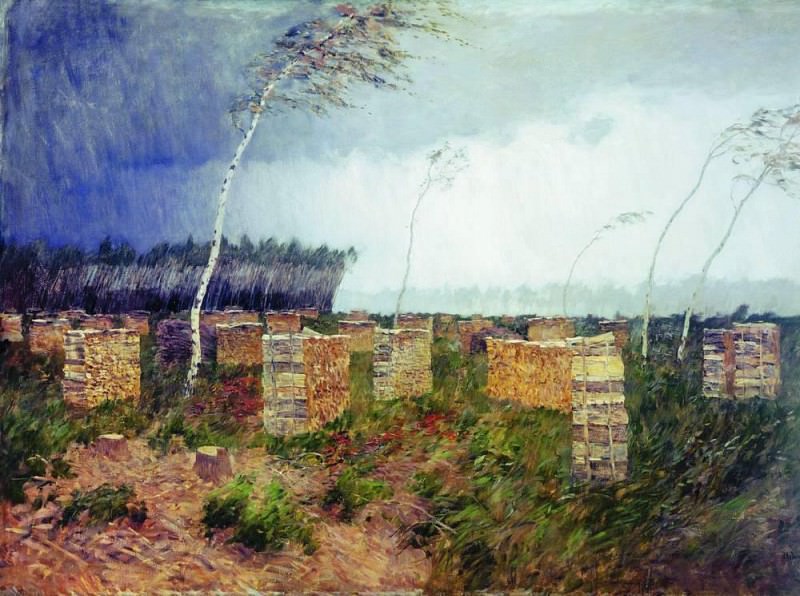Storm. Rain. 1899 Isaac Ilyich Levitan (1860-1900)
Isaac Ilyich Levitan – Storm. Rain. 1899
Edit attribution
Download full size: 1000×744 px (0,1 Mb)
Painter: Isaac Ilyich Levitan
This painting was painted in 1899. It is almost the last major work of the great artist. The viewer is presented with a view of a cold autumn sky. With gray, disheveled clouds. Dense gloom spreads already halfway across the sky. The approach of the thunderstorm can be felt in everything. Slanting streams of rain cover all visible space. The wind tears the grass, darkened by inclement weather, and sweeps it together with yellowing fresh sawdust.
Description of Isaac Levitan’s painting "Storm. Rain."
This painting was painted in 1899. It is almost the last major work of the great artist.
The viewer is presented with a view of a cold autumn sky. With gray, disheveled clouds. Dense gloom spreads already halfway across the sky. The approach of the thunderstorm can be felt in everything.
Slanting streams of rain cover all visible space. The wind tears the grass, darkened by inclement weather, and sweeps it together with yellowing fresh sawdust. Gusts of wind are so strong that the thin birch trees are bent to the ground.
The same bent tree silhouettes are also in the background. The tree stumps and neatly stacked firewood remain calm to all that is going on. The cold downpour is watering them too. And they look bleak and orphaned.
The outstanding Russian landscape painter was the first to succeed in conveying the sad power of the immeasurable distance of Russian bad weather. The viewers see in the painting an intensification of the narrative through the artist’s use of pictorial and compositional means.
Here one can see the uncommonness of the subject and the expression of the interpretation. The main tone of the painting is heavy, cold red hues. Warm colors are also used in the work, but the artist purposely left them muted.
The viewer appears chaotically scattered, thanks to the broad strokes, grass, sawdust. And it all seems to be scattered by the wind that came from nowhere. The image of birch trees on the horizon and the sky was made with light strokes. Dark, almost black tones as well as light gray were used to depict it.
The painting can be called a panorama because of its elongation and the bending of the trees. In 1899 there was a travelling exhibition and this work was exhibited there. The picture turned out with its nervous, expressive interpretation and subject matter, so it was immediately noticed.
Кому понравилось
Пожалуйста, подождите
На эту операцию может потребоваться несколько секунд.
Информация появится в новом окне,
если открытие новых окон не запрещено в настройках вашего браузера.
You need to login
Для работы с коллекциями – пожалуйста, войдите в аккаунт (open in new window).




















You cannot comment Why?
This painting depicts a desolate landscape under a dramatic, stormy sky. The foreground is dominated by numerous neatly stacked piles of cut wood, suggesting deforestation or preparation for fuel. Scattered among them are tree stumps, reinforcing the theme of human intervention in nature. Slender, windswept trees, particularly a white-barked birch on the left, are bent dramatically by a strong gale. In the background, a dense line of trees stretches across the horizon, agitated by the wind and partially obscured by the approaching storm.
The sky is a turbulent mix of dark, rain-filled clouds on the left, transitioning to lighter, overcast tones toward the right, with a hint of diffused light breaking through. The overall impression is one of raw, untamed nature being battered by the elements, with the presence of the cut wood and stumps serving as a somber reminder of human impact.
The subtexts of the painting can be interpreted in several ways: